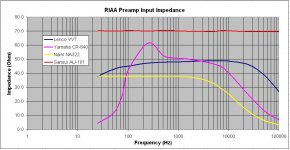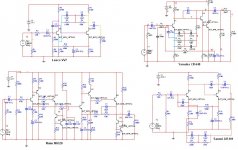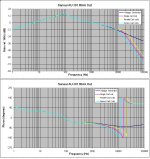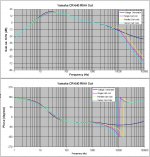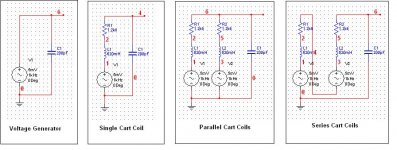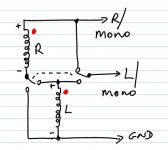Yes, though as you say the effect is typically small - then again if there is +40dB of current overload as it seems, maybe it might get interesting for some carts?Don't you also get the shunt trying to be a motor? so as well as loading the other coil its moving the stylus (albeit a tiny amount)?
Trust you had a good break, Scott.I was away for the hoilday but I would like to add my vote for ways to measure the stylus temperature. I've used Liquid-crystal thermography on chips and the resolution in both temperature and space is ideal here.
I think there's some confusion about the size and location of the region of interest here. It's two patches about 1um or so in linear dimension, the locus of contact between stylus and groove. Not only is it inaccessible, the dimensions are far smaller than the wavelength of infrared radiation, so direct observation seems impossible I think.
The best hope perhaps is to rely on the fact of fantastic thermal conductivity within the stylus, and observe the whole stylus body. Then calculate the thermal gradient within the stylus, easy enough for sphericals, when the heat source has a small locus on a spherical surface. I did this calc a few years back, and remember the result that thermal gradient within the stylus is negligible - can't find the calcs now or would re-up them. I did find thermal gradient calcs for a cantilever at 5mW, and temp difference between cantilever ends is ~ 0.5 deg.
To confirm, I attached a tiny thermocouple to the stylus top shank, and obtained negligible temp rise. Thermal imaging should be able to see the whole stylus, but not see or resolve the nitty gritty. Still would be good to do.
To confirm, I attached a tiny thermocouple to the stylus top shank, and obtained negligible temp rise. Thermal imaging should be able to see the whole stylus, but not see or resolve the nitty gritty. Still would be good to do.
Just thinking of how to eliminate the error from thermal mass of the wires.
Yes -remember that the Concorde is has an integrated headshell, so no option for alignment alteration AFAIK. Whereas the OM body versions allow one to tinker........well looks like the concorde will fit my kenwood KD-550. Given the hi-fi concorde tips are still available as well as the bulldozer dj version I am sorely tempted.
Yes, that's interesting, the joys of servos. It's the case where |Zin| dips significantly that might be interesting I think for certain carts. Perhaps it's a small step in your sims to look at input current when driven from a cartridge LR source, George, might be interesting?I am reading the opinions about coils loading with interest and I thought of the input impedance of the RIAA preamplifier.
I simulated the input impedance of four different circuits.
Yes -remember that the Concorde is has an integrated headshell, so no option for alignment alteration AFAIK. Whereas the OM body versions allow one to tinker........
I'm saving for an SME3009 so would have the adjustability. I downloaded the Bob Cordell Linear audio article last night to look at his damped mode RIAA. In a nutshell you load the coil with a low enough R to give you the 75uS EQ, with a strategic pole to keep the slope right. Neatly gets around any issues that you get with series coils. I may have to build one channel of that...
The idea goes way back, don't know if you know the fantastic story about Barney Oliver, Head of HP R&D, who used HP methodology and resources to design a preamp on these principles......?I downloaded the Bob Cordell Linear audio article last night to look at his damped mode RIAA. In a nutshell you load the coil with a low enough R to give you the 75uS EQ, with a strategic pole to keep the slope right. Neatly gets around any issues that you get with series coils. I may have to build one channel of that...
http://www.hparchive.com/Manuals/Barney_Oliver_Amplifier_Manual.pdf
A few years back I designed several true transimpedance preamps which present near-zero input impedance, and I sort out the resulting eq train crash in the RIAA network. If the cartridge can thrive on the load conditions, results can be sublime IME. I still use one as my main critical listening rig. The OM40 is particularly nice in this mode, IME.
Moreover, near-zero input impedancet solves the problems with parallel MM mono wiring mentioned on this thread, and/or works well with series mono wiring, if the cart tolerates it. Ortofon OM series MM carts work well in this mode, IME.
I also designed a valve version of the Barney Oliver preamp, which I keep and use on a second rig. So I habitually use low input impedance a lot for MM preamps..........don't tell anyone
Just thinking of how to eliminate the error from thermal mass of the wires.
thermal mass of lead wires (affecting measurement of transients) and convective cooling across the lead wires (affecting both transients and steady state measurements)
Perhaps it's a small step in your sims to look at input current when driven from a cartridge LR source, George, might be interesting?
I chose the Sansui AU-101 with the flattest input impedance and the Yamaha CR-640 with the most varying input impedance for to sim the preamp output when the four different sources are connected to their input (note the gain is rel 1kHz in each case, so the +6db for the series coils is not shown)
lucky, I have reservations as to how well these source models are able to show what really happens when coils are in series or parallel connected
George
Attachments
The idea goes way back, don't know if you know the fantastic story about Barney Oliver, Head of HP R&D, who used HP methodology and resources to design a preamp on these principles......?
http://www.hparchive.com/Manuals/Barney_Oliver_Amplifier_Manual.pdf
BC references a 2012 application, but it was one of those ideas that was so obvious I knew it must have been used waaaay back. And it's so obvious that you really go 'd'uh why didn't I see that' like so many clever things.
Will have a read of the Barney Oliver article. hell even as an undergrad I couldn't understand why hifi preamps weren't designed on intrumentation principles. When I became a little less naive I realised that high end wasn't about doing things well!
But I abandoned MM in 1988. Only now actually re-appraising it.
Indeed, seems Barney Oliver's was in the public domain in the 1970s.BC references a 2012 application, but it was one of those ideas that was so obvious I knew it must have been used waaaay back. And it's so obvious that you really go 'd'uh why didn't I see that' like so many clever things.
About 4 years back I came up with what I thought was a neat topology for a true transimpedance phono input stage, including how to solve the awkward incorrect filter pole with arises from the natural LR of the cartridge. Only to find this in the search, from 1982, which already discloses it:
http://patentimages.storage.googleapis.com/pdfs/US4470020.pdf
well at least good to know you aren't mad! I do seriously hope that there will be a proper reappraisal of MM at least amongst DIY types. I have yet to see a properly designed commerical MM preamp. There must be some somewhere...surely. Or are users considered to stupid to google for the Z of their cartridge?
Yes. Thanks for posting those sims, George. I agree that source models as a voltage source with series RL probably typically doesn't say it all under abnormal load conditions. Not least because of non-ideals in magnetics and mechanics which might vary with operating point. IME yes this can vary greatly between cartridges, unfortunately.lucky, I have reservations as to how well these source models are able to show what really happens when coils are in series or parallel connected
I do seriously hope that there will be a proper reappraisal of MM at least amongst DIY types.
I don't. Keep them affordable!
I have yet to see a properly designed commerical MM preamp. There must be some somewhere...surely.
I'm sure there's one out there, somewhere. I designed my own because all of the published designs (except for one or two) I could find had serious issues. And the exceptions, though very well designed (yes, I mean Self and Cordell), didn't do a proper job of running balanced.
There must be some somewhere...surely. Or are users considered to stupid to google for the Z of their cartridge?
Funny seeing phono and google together while talking about circuits from the 80's
- Status
- This old topic is closed. If you want to reopen this topic, contact a moderator using the "Report Post" button.
- Home
- Source & Line
- Analogue Source
- vinyl coefficient of friction
